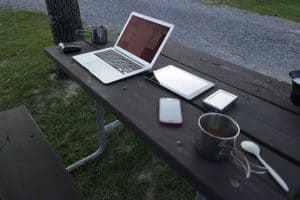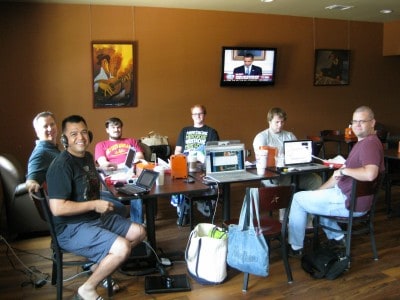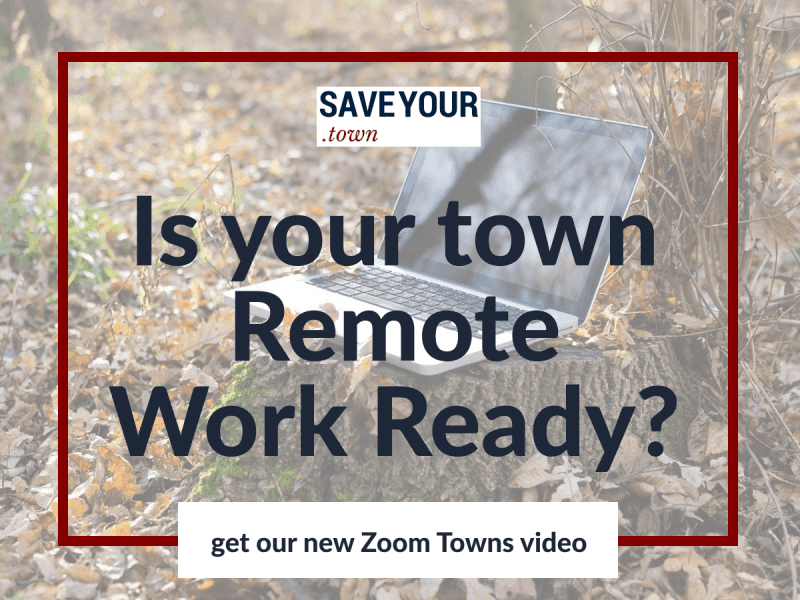||

If you can work from anywhere, why not work from a small town? Photo by Becky McCray.
Remote work will dominate the future small town workforce
Your current residents
Your current small town residents will increasingly work from home or remotely.
Gallup looked at jobs that could be done remotely and the locations where workers actually did them. Four times as many workers will work remotely going forward, compared to the number in 2019. Up to 24% of all remote-capable jobs primarily will done remotely in 2022 and beyond, and that’s more than the 23% who expect to work primarily on site.
And most people in the workforce like it that way. In a 2022 Axios Harris 100 poll, 84% of millennials say remote work is important vs. 66% of Gen Z, 75% of Gen X and 68% of Boomers.
Your young people
Some of the new people who will be remote workers in the future are actually your own young people. Kids who are using distance learning today are your future remote workforce. They’re learning how to use the technology right now, and they already live here.
Your new residents
You will also see new people moving in who bring their job with them via remote work, or bring their own business with them.
Research from 2015, 2018 and 2021 shows that there is pent up demand for rural living, and way more people prefer living in rural places than urban.
What remote workers need in small towns
We’ve talked before about what makes your town attractive to remote workers.
Since your current residents, young people and future residents will increasingly work remotely, what will they need from their community in order to thrive?
Qatalyst Research Group shared their findings from a review of current programs from big cities and small towns all over the world that attract remote workers. Common tactics included:
- offering financial incentives
- providing coworking spaces
- building a community of remote workers
Those are the supports that remote workers with a choice are looking for, so these are the supports for rural remote workers we’ll talk about in this article:
- Incentives to live here
- Places to work
- A sense of community

Incentives for rural remote workers often center on housing, including land giveaways and cheap building lots. Photo by Becky McCray.
1. Incentives to live here
Your first thought might be big-city style “come live here and we’ll give you thousands of dollars” incentives. That’s not your only option or even your best option for small towns.
Promote incentives for current residents to stay
Don’t just think about luring new people. Think about what rewards your local people to live here.
Start combing lists of benefits any local resident could qualify for. It could be a special program based on income or residency. Or it might be something a local business offers that helps local people. Get creative!
- homebuyer assistance
- weatherization and energy efficiency help for existing houses
- free checking at the local bank
- media services at the library
I’m sure you can brainstorm a longer list from local, regional and state agencies that serve your community. Make sure your local residents know how to tap all that they qualify for.
Create small-town sized incentives to move in.
You’ve heard of small towns offering free or reduced price lots for homebuilding for new residents. Most small towns could also offer reduced city utilities for the first few months.
In some places, you can promote your streamlined permitting process. James Decker pointed out the difference in homebuilding between his town Stamford, Texas, and Austin, Texas: “you can get permitted in like a day.” compared to it taking 100+ days.
You can also promote most of the incentives you found for current residents because they’ll apply for new residents, too.
Entice alumni with “come home” projects:
People who once lived in your town are an easy target for living in your town again. Here are some ways to encourage them to consider a return.
Hold awe inspiring alumni reunions. Cross the year boundaries and combine all the classes. Do this more than once every hundred years. Waynoka, Oklahoma, does it every 5 years.
Include all alums. Private schools, church schools, rural schools, vo-tech schools, schools now closed or consolidated, all the schools you can think of. Remember the colleges, universities, junior colleges, beauty schools, and trade schools. Include the pre-schools.
Develop an outstanding mailing list of alums. Use it wisely to promote your the quality of your town, events and opportunities to return.
Make sure that alumni groups know about the incentives you’ve compiled and mention them regularly.

Workshifting at the RV park. Photo by C.C. Chapman
2. Places to work
Create more flexible workspaces: Third Workplaces
With more people working remotely, more people are working from places that are neither their offices or their homes. Cue the rise of the Third Workplace.
You may remember “third places” as places you hangout that aren’t home and aren’t work. Coffee shops, bars and places like that. “Third workplaces” are places you work that aren’t home and aren’t the office.
One of our favorite trendwatchers, Emergent Research said:
We’re seeing signs that, thanks to the shift to remote work, the paradox of place is breaking down and workers and companies are geographically spreading out.We expect both the trends towards greater use of 3rd places for work and economic de-agglomeration to continue.
Different people will like different kinds of workplaces.
Some people want a noisy coffee shop. Some will like quiet libraries. Some want a more homey place, and others will feel more business-like in an office-style setting. Whatever the feel of the work space you create, there is someone who will love it.
Create appealing co-working spaces
A 2015 co-working study from Emergent Research and partners showed that coworking spaces are human spaces.
“The key finding is while coworking spaces are definitely workspaces, they are also much more,” they said. “They are places where members work, network, learn and socialize together.”
In their research, coworking members reported:
- improving professional success
- learning new skills
- attending events at the coworking space
- feeling happier and less lonely in their work.
- Those are all outcomes you’d love to see from any entrepreneurial program in your town!
Where to find space
You probably have some office space in a local business incubator, belonging to an economic development group, or in a local educational facility that you could re-purpose. Maybe you have a business that just has way more office space than they need. Or there’s an empty building with potential.
The key element is community. I successfully persuaded my friends at the Northwest Oklahoma Small Business Development Center in Alva to convert an under-utilized space for coworking. They had the space, outstanding wifi, desks, chairs and all the extras. What we didn’t have was a ready-made community to connect to it. So it didn’t get as much use as we would have liked, and they ended the experiment. We needed to build the community for it to work.
Connect with local people who work from home, coffee shops, the library or any other alternative space. Begin holding work-together days, like Fridays from 10-2 or something. You don’t need a special space for the meetups. The library, coffee shop, or even one big home office will work for now.
Joel Bennett of Pella, Iowa, helped pioneer a co-working space in his town. You can read his 5 tips for starting small-town co-working and listen to an audio interview with Joel on co-working. Sneak peek: he talks a lot about building community before finding a building.
Informal work space: the low-budget version of co-working
If you don’t have a coworking space in your town now, there are small steps you can take now. Find creative alternative places where remote workers can connect with each other and get some work done.
Where can you find unofficial coworking spaces?
- Start with the public library. They have work areas.
- Maybe a local hotel, motel or bed and breakfast has a workstation or two for guests.
- Whatever organization or business you work for, could you set up a guest workstation in your office? Economic development groups or chambers might be first to volunteer.
- Look for businesses that aren’t using all of their space.
- Maybe an insurance company has some open space up front.
- Maybe an attorney has an extra office they don’t use.
- What about the church fellowship hall or youth center? Would they accept folks for coworking?
As you share your lists of alternative work spots, you’ll be starting to build your remote work community.
Bonus: Nature offices
Working where you have a view of nature makes you more productive. Small towns and rural communities have easy access to nature. Put that together and your town can make nature offices an advantage for your remote workers.
There are plenty of options for creating nature offices.
Start with the public parks. Make sure there’s wifi coverage, then look for picnic tables, shelters or other places someone could plop down a laptop and start working. Add electrical outlet access as a bonus.
Local businesses could set up tiny offices. Those could be in tiny houses, attractive work sheds, or tiny mobile office trailers. Add power and satellite internet access. Put them in natural settings, rural locations or park-like areas in a small town.
Put several tiny offices together for a mini-co-working community with a nature view.

Coworking groups and clubs can provide that sense of community remote workers need. Photo by Sheila Scarborough.
3. A sense of community
Find a co-working group or make one.
Even small towns can support simple co-working groups. Just take your laptops to a local eatery or the library and spend Friday afternoons together. Even 2 or 3 people together can make your week more interactive.
Remote worker and artist Andrea Cook said, “Today’s social revolution is in need of a reality check and the independent professional is in desperate need of true community.”
Andrea helped pioneer Jelly Week events to support co-working and independent workers in her community.
Attend other in-person events in town.
Join the chamber of commerce. Invite friends for networking. Become part of a group. Attend all kinds of performances and events locally just to get out of the house.
More local chambers are actively reaching out to home-based businesses and independent professionals, and that includes remote workers. Some chambers, like the one in Caldwell, Kansas, do report more home-based businesses joining as members, but they don’t participate in events and activities.
Chambers and other organizations can do more to create the projects, events and activities that connect with what remote workers want and need. Start by listening to remote workers to find out what those are.
Practical steps for Zoom Towns and becoming remote work ready
Find more practical steps you can take in our video Remote Work Ready: Zoom Towns. Everything you’ll learn is do-able, affordable and scaled for small towns.

Is your town remote work ready? Get practical steps in SaveYour.Town’s Zoom Towns video
----------------------------------------------------------------
By: Becky McCray
Title: 3 Major factors in rural remote work: incentives, flexible workspaces, and a sense of community
Sourced From: smallbizsurvival.com/2022/06/3-major-factors-in-rural-remote-work-incentives-flexible-workspaces-and-a-sense-of-community.html
Published Date: Mon, 06 Jun 2022 13:19:47 +0000
Did you miss our previous article...
https://coachingbusinessowners.com/growth/5-content-marketing-ideas-inspired-by-the-rock






